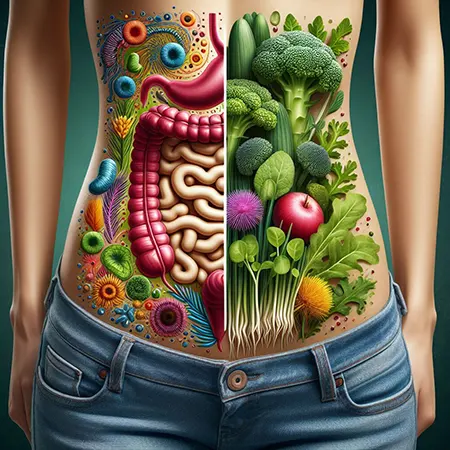Microgreens: Tiny Powerhouses for a Thriving Gut
In a world increasingly focused on gut health, microgreens have emerged as unexpected superstars. These miniature marvels, harvested at the peak of their youthful potential, pack a powerful punch of nutrients. However their benefits extend far beyond vitamins and minerals. Microgreens offer a unique advantage: they can actively promote a healthy gut microbiome, the foundation of our digestive and overall well-being. This article delves into the fascinating science behind how microgreens act as both prebiotics and probiotics, nurturing a thriving gut environment.

The Gut Microbiome: A Delicate Dance
Imagine a bustling metropolis within your body. This is the gut microbiome, a complex ecosystem inhabited by trillions of bacteria, both friendly and unfriendly. These microscopic residents play a crucial role in digestion, nutrient absorption, immune function, and even mood regulation. A healthy gut microbiome thrives on a delicate balance between beneficial and harmful bacteria. When this balance tips, it can lead to a cascade of digestive issues, including bloating, constipation, diarrhea, and even chronic health problems.
The Prebiotic Powerhouse: How Microgreens Feed Your Gut Garden
Dietary fiber is like the unsung hero of digestion, and microgreens are its enthusiastic cheerleaders. But unlike the mature plants they'll eventually become, microgreens contain a special type of fiber known as prebiotics. These prebiotics are like fertilizer for the good bacteria that reside in your gut, specifically the ones in your large intestine.
Here's how microgreens work their magic:
-
Indigestible Delights: Unlike other carbohydrates, our bodies can't break down prebiotics in the small intestine. They travel relatively unscathed through the digestive system until they reach the colon, the final frontier.
-
A Feast for Friendly Flora: Once in the colon, prebiotics become a food source for the beneficial bacteria that call this area home. These bacteria consume the prebiotics and, in turn, thrive and multiply.
-
A Crowded Out Competition: As the good bacteria flourish due to the prebiotic feast, they start to occupy more space and resources in the colon. This leaves less room and fewer nutrients for harmful bacteria to survive, effectively crowding them out.
-
A Thriving Gut Ecosystem: By promoting the growth of beneficial bacteria and limiting the harmful ones, microgreens help create a balanced and healthy gut microbiome. This balanced environment is essential for optimal digestion, nutrient absorption, immune function, and overall well-being.
Beyond Basic Fiber:
While all fiber is beneficial, prebiotics offer a specific advantage. They act as selective fertilizers, nurturing the growth of specific strains of good bacteria known to promote gut health. This targeted approach helps maintain a diverse and robust gut microbiome, which is crucial for overall health.
Examples of Prebiotic Powerhouses in Microgreens:
- Inulin: Found in chicory and dandelion microgreens, inulin is a well-studied prebiotic that supports the growth of Bifidobacteria, a key player in gut health.
- Fructooligosaccharides (FOS): Present in onion and garlic microgreens, FOS are another type of prebiotic that nourishes beneficial bacteria like Lactobacilli, known for their role in digestion and immune function.
By incorporating microgreens into your diet, you're not just adding a burst of flavor and nutrients, you're providing valuable nourishment for the good bacteria in your gut, laying the foundation for a healthy digestive system and a happier you.

Probiotics in Microgreens: Unveiling the Potential
While microgreens themselves don't directly contain live probiotic bacteria, they can indirectly support their function in several ways. Certain microgreens are grown using fermentation techniques, which may introduce beneficial probiotic strains. Additionally, the rich tapestry of bioactive compounds found in microgreens, such as antioxidants, polyphenols, and enzymes, can create an ideal environment for existing probiotic bacteria to thrive. These compounds may help to reduce inflammation, improve gut barrier function, and provide essential nutrients for probiotic growth.
Choosing Your Gut-Friendly Microgreen Warriors
Not all microgreens are created equal when it comes to gut health. While all varieties offer prebiotic benefits, some stand out as particularly potent allies:
-
Cruciferous Champions: Broccoli, radish, and arugula microgreens are packed with sulforaphane, a powerful compound that supports detoxification and promotes the growth of beneficial bacteria. Sulforaphane has been shown to reduce inflammation and protect against gut-related cancers.
-
Herb Haven: Basil, cilantro, and dill microgreens are brimming with essential oils that possess anti-inflammatory properties. These oils may help soothe the gut lining, reduce bloating, and create a more hospitable environment for beneficial bacteria.
-
Sunflower Powerhouse: Sunflower microgreens are a double threat, offering a significant prebiotic boost and a healthy dose of omega-3 fatty acids. Omega-3s are known for their anti-inflammatory properties, which can help reduce gut inflammation and promote a healthy gut lining.
Unlocking the Flavor and Functional Power of Microgreens
The beauty of microgreens lies in their versatility. These tiny flavor bombs can be effortlessly incorporated into your daily meals, transforming them into gut-loving masterpieces:
-
Salad Sensations: Sprinkle a vibrant mix of microgreens over your salads for a burst of flavor, color, and a concentrated dose of prebiotics.
-
Smoothie Superstars: Blend microgreens into your morning smoothies for a convenient and delicious way to jumpstart your day with a prebiotic punch.
-
Sandwich Saviors: Elevate your sandwiches and wraps with a layer of microgreens for added texture, taste, and a boost of gut-friendly nutrients.
-
Soup and Stew Swagger: Stir microgreens into your soups and stews just before serving to add a touch of freshness and a surge of prebiotic power.
Embrace the Power of Organic
Whenever possible, opt for organic microgreens. This helps to minimize your exposure to pesticides and herbicides, which can harm the delicate gut microbiome. By choosing organic, you're not only nourishing your body but also protecting the environment.
Conclusion:
Microgreens are more than just a culinary trend; they are potent allies in your quest for a healthy gut. Their prebiotic properties and potential to support probiotic function make them a valuable addition to a gut-centric diet. Embrace the vibrant world of microgreens and unlock a new dimension of flavor.

